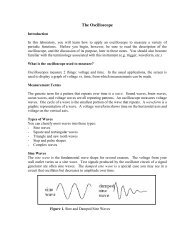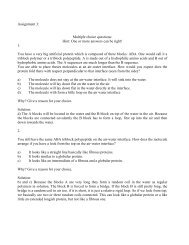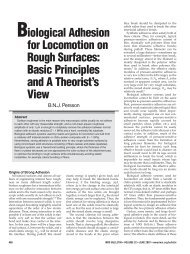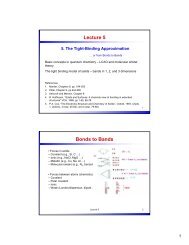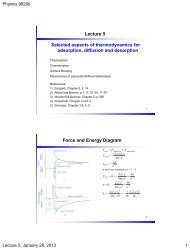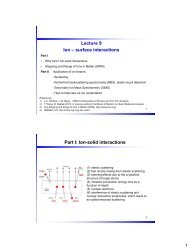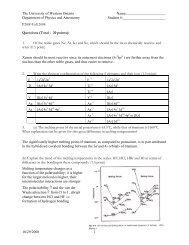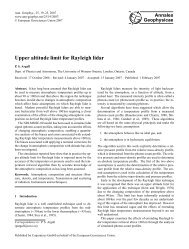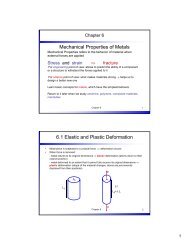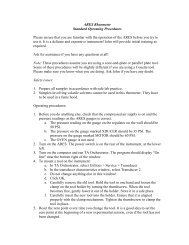Spin-Wave Quantization in Ferromagnetic Nickel Nanowires
Spin-Wave Quantization in Ferromagnetic Nickel Nanowires
Spin-Wave Quantization in Ferromagnetic Nickel Nanowires
Create successful ePaper yourself
Turn your PDF publications into a flip-book with our unique Google optimized e-Paper software.
VOLUME 89, NUMBER 2 PHYSICAL REVIEW LETTERS 8JULY 2002<strong>Sp<strong>in</strong></strong>-<strong>Wave</strong> <strong>Quantization</strong> <strong>in</strong> <strong>Ferromagnetic</strong> <strong>Nickel</strong> <strong>Nanowires</strong>Z. K. Wang, M. H. Kuok,* and S. C. NgDepartment of Physics, National University of S<strong>in</strong>gapore, S<strong>in</strong>gapore 117542, Republic of S<strong>in</strong>gaporeD. J. LockwoodInstitute for Microstructural Sciences, National Research Council, Ottawa, K1A 0R6, CanadaM. G. CottamDepartment of Physics and Astronomy, University of Western Ontario, London, Ontario N6A 3K7, CanadaK. Nielsch, R. B. Wehrspohn, and U. GöseleMax-Planck-Institute of Microstructure Physics, We<strong>in</strong>berg 2, D-06120 Halle, Germany(Received 31 January 2002; published 19 June 2002)The dynamical properties of uniform two-dimensional arrays of nickel nanowires have been <strong>in</strong>vestigatedby <strong>in</strong>elastic light scatter<strong>in</strong>g. Multiple sp<strong>in</strong> waves are observed that are <strong>in</strong> accordance withdipole-exchange theory predictions for the quantization of bulk sp<strong>in</strong> waves. This first study of thesp<strong>in</strong>-wave dynamics <strong>in</strong> ferromagnetic nanowire arrays reveals strong mode quantization effects and <strong>in</strong>dicationsof a subtle magnetic <strong>in</strong>terplay between nanowires. The results show that it is important to takeproper account of these effects for the fundamental physics and future technological developments ofmagnetic nanowires.DOI: 10.1103/PhysRevLett.89.027201Regular arrays of magnetic submicrometer-size dotsand wires are currently attract<strong>in</strong>g great <strong>in</strong>terest due to their<strong>in</strong>terest<strong>in</strong>g physics and potential applications <strong>in</strong> magneticsensors and memory devices [1,2], and their static propertieshave been studied extensively [3–7]. Their dynamicalproperties are of fundamental importance <strong>in</strong> evaluat<strong>in</strong>gthe time scale of the magnetization reversal process,which governs the writ<strong>in</strong>g time <strong>in</strong> magnetic storagedevices [8–10]. The low-energy magnetic excitationsor sp<strong>in</strong> waves (SWs) that def<strong>in</strong>e the time scale are best<strong>in</strong>vestigated via Brillou<strong>in</strong> (<strong>in</strong>elastic) light scatter<strong>in</strong>g (BLS)[11]. Only surface SWs have been observed so far byBLS <strong>in</strong> deep-etched micron-size magnetic circular dotsand rectangular wires [12–15]. Here we employ BLSto study SWs <strong>in</strong> highly ordered arrays of ferromagneticnickel nanowires, fabricated by self-assembly <strong>in</strong> Al 2 O 3templates follow<strong>in</strong>g Nielsch et al. [16,17], and analyze theresults by adapt<strong>in</strong>g a recent dipole-exchange theory forcyl<strong>in</strong>drical nanowires [18]. Our novel results reveal threeSWs whose frequencies sharply <strong>in</strong>crease with decreas<strong>in</strong>gdiameter. The theory shows that these modes are causedby the radial quantization of bulk SWs. Besides its fundamentalsignificance for the physics of nanomagnets, suchquantization and also <strong>in</strong>terwire coupl<strong>in</strong>g are factors thatwill strongly <strong>in</strong>fluence nanomagnetic device performance.The two-dimensional arrays of nickel nanowires wereprepared <strong>in</strong> the follow<strong>in</strong>g way. Hexagonally orderedporous Al 2 O 3 templates were first fabricated on alum<strong>in</strong>umsubstrates us<strong>in</strong>g a two-step electrochemical anodizationprocess [19]. By means of pulsed electrodeposition, theresult<strong>in</strong>g high-aspect-ratio porous alum<strong>in</strong>a templates werehomogeneously filled with nickel [16]. Scann<strong>in</strong>g electronPACS numbers: 75.10.Jm, 75.30.Ds, 75.75.+a, 78.35.+cmicrographs of the nanowire structures [17] revealed thatthey have a length of about 1 mm and a periodic wirespac<strong>in</strong>g of 100 nm, with respective nanowire diameters of30, 40, and 55 nm. Samples of nanowires with a 25 nmdiameter and <strong>in</strong>terwire separation of 65 nm were alsoobta<strong>in</strong>ed. Us<strong>in</strong>g superconduct<strong>in</strong>g quantum <strong>in</strong>terferencedevice magnetometry [17], the saturation magnetization,M s , of the nickel nanowires was found to be 0.0480 T.Brillou<strong>in</strong> spectra at room temperature were recorded <strong>in</strong>the 180 ± backscatter<strong>in</strong>g geometry us<strong>in</strong>g a 3 1 3-passtandem Fabry-Pérot <strong>in</strong>terferometer equipped with a siliconavalanche diode detector, and the 514.5 nm l<strong>in</strong>e ofan argon-ion laser. The laser light was <strong>in</strong>cident on thetop surface of each alum<strong>in</strong>a membrane such that the surfacenormal, which is parallel to the symmetry axes ofthe nanowires, lies <strong>in</strong> the scatter<strong>in</strong>g plane. Measurementswere made <strong>in</strong> p-s polarization configurations, with a typicaldata acquisition time of 8 h. Figure 1 shows a typicalp-s polarized anti-Stokes Brillou<strong>in</strong> spectrum (whichis similar to the Stokes spectrum) <strong>in</strong> zero applied field,recorded at an <strong>in</strong>cident angle of 45 ± , of a 30 nm diameternickel nanowire sample, which features three Brillou<strong>in</strong>peaks. S<strong>in</strong>ce they appear symmetrically, <strong>in</strong> the respectiveStokes and anti-Stokes spectra, about the elastic peak andtheir positions shift on application of a magnetic field (see<strong>in</strong>set of Fig. 1), they are attributed to bulk SWs. The spectralpeaks were fitted with a Lorentzian function, as shown<strong>in</strong> Fig. 1, and the variation of the fitted SW frequencieswith the nanowire radius is displayed <strong>in</strong> Fig. 2. The <strong>in</strong>setof Fig. 1 shows the variation of the SW frequencies whena magnetic field is applied transverse to the axis of thenanowires. This field causes a cant<strong>in</strong>g of the magnetization027201-1 0031-90070289(2)027201(3)$20.00 © 2002 The American Physical Society 027201-1
VOLUME 89, NUMBER 2 PHYSICAL REVIEW LETTERS 8JULY 2002Intensity (arb. units)Frequency (GHz)30201000.0 0.4 0.8Magnetic Field (T)10 20Frequency (GHz)FIG. 1. Brillou<strong>in</strong> anti-Stokes spectrum of the 30 nm diameternickel nanowire sample <strong>in</strong> zero applied magnetic field. Experimentaldata are denoted by dots. The peaks are due to the threebulk sp<strong>in</strong> waves. The spectrum is fitted with Lorentzian functions(dotted curves) and a background (dashed curve); the fullfitted spectrum is shown as a solid curve. The <strong>in</strong>set shows thebulk sp<strong>in</strong>-wave frequencies versus applied magnetic field for thesame sample.direction, which acquires a component <strong>in</strong> the transversedirection (for which the demagnetiz<strong>in</strong>g field is 2pM s 0.30 T). It is noticeable that there is a different behaviorfor the SW frequencies above and below this approximatefield value.Frequency (GHz)30201000 20 40Radius (nm)m = 1m = 2m = 3BulkFIG. 2. Variation of bulk sp<strong>in</strong>-wave frequencies with nanowireradius <strong>in</strong> zero applied magnetic field. The experimental datapo<strong>in</strong>ts, for each radius, correspond to the three values of theazimuthal quantum number m. The solid curves representthe respective best fits of the experimental data with Eq. (4).The diamond denotes the frequency of the bulk sp<strong>in</strong> wave forbulk nickel [20].The theory of Arias and Mills [18] was formulatedfor dipole-exchange SW excitations <strong>in</strong> ferromagneticnanowires of circular cross section, where the magnetizationis parallel to the axis of the wire. In this theory thegeneral form of the magnetic scalar potential with<strong>in</strong> thenanowire, as obta<strong>in</strong>ed from the Bloch equation of motionwith dipole field terms and exchange terms <strong>in</strong>cluded, canbe expressed <strong>in</strong> cyl<strong>in</strong>drical coord<strong>in</strong>ates asF M r, f, z J m qr expimf expikz . (1)Here k is the component of the SW wave vector alongthe z direction (parallel to the axis of a nanowire), andJ m qr is a Bessel function of order m ( 1, 2, 3, . . .). Thecomplex variable q is found from the roots of a sixth-orderpolynomial [18]. In the case of zero applied magnetic field,we f<strong>in</strong>d that this can be factorized asq 2 1 k 2 Dq 2 Dq 2 1 4pM s 1 2Dk 2 1Dk 2 2 2v 2 0, (2)where D is the exchange stiffness, M s is the saturationmagnetization, and v is the SW frequency. The bulk stand<strong>in</strong>gmodes of the nanowires correspond to real values of q(which has the role of a SW radial wave vector component)and thus correspond to SW frequencies that are given byv Dq 2 Dq 2 1 4pM s 1 2Dk 2 1 Dk 2 2 12 . (3)The full theory [18] requires tak<strong>in</strong>g <strong>in</strong>to account numericallythe “mix<strong>in</strong>g” of the bulk SWs with the surfaceSWs, which correspond to imag<strong>in</strong>ary values of q, togetherwith boundary conditions. Here we modify this approachto obta<strong>in</strong> an approximate analytic theory applicable forsmall and large p<strong>in</strong>n<strong>in</strong>g [11], for which the radial functionJ m qr will have ant<strong>in</strong>odes and nodes, respectively, atr R (the radius of a nanowire). Denot<strong>in</strong>g a m q m R,the lowest three values are a 1 1.84, a 2 3.05, anda 3 4.20 for m 1, 2, and 3, respectively, <strong>in</strong> the case ofsmall p<strong>in</strong>n<strong>in</strong>g. The correspond<strong>in</strong>g numbers for large p<strong>in</strong>n<strong>in</strong>gare a 1 3.83, a 2 5.14, and a 3 6.38.The expression for v can be further simplified if k 2 øa m R 2 (see discussion below):Ω µ ∂ 2∑ µ ∂ 2∏æ 12 am amv D D 1 4pM s . (4)R RThe above equation is used to fit our results with Das a parameter and M s fixed at the measured value of0.0480 T [17]. Figure 2 shows that the fit thus obta<strong>in</strong>edis good, <strong>in</strong> the case of small p<strong>in</strong>n<strong>in</strong>g, and yields D 3.13 3 10 214 Tcm 2 , which is some 11 times smaller thanthat obta<strong>in</strong>ed by Sandercock and Wettl<strong>in</strong>g [20] <strong>in</strong> a BLSstudy of SWs <strong>in</strong> bulk nickel. The reason for this discrepancymay be associated with the different sample geometryand direction of the SW wave vector (compared toRef. [20]) or, more likely, due to the long-range dipolarfields of the surround<strong>in</strong>g nanowires <strong>in</strong> the array. The fitto the experimental data is poor for large p<strong>in</strong>n<strong>in</strong>g, thusimply<strong>in</strong>g that the surface anisotropies <strong>in</strong> the nanowiresamples are small.027201-2 027201-2
VOLUME 89, NUMBER 2 PHYSICAL REVIEW LETTERS 8JULY 2002Our k 0.041 nm 21 and therefore k 2 1.6 310 23 nm 22 . Now a m R 2 ranges from 4.48 3 10 23 to0.11 nm 22 and therefore k 2 ø a m R 2 , thus justify<strong>in</strong>gour use of Eq. (4). A measure of the relative importance ofthe exchange to dipolar coupl<strong>in</strong>g on a SW at wave numberk is given by r Dk 2 4pM s 12 (see, e.g., Ref. [21]).In the case of our nickel nanowires r 0.093, whichis small, but not sufficiently small that exchange effectsmay be neglected. Another measure is the exchangelength, def<strong>in</strong>ed as rk, which has the value of 2.27 nmfor the nickel nanowires. The range of radii R studied,12.5 to 27.5 nm, is larger than the exchange length, butnot by a very large factor. This clearly <strong>in</strong>dicates that adipole-exchange theory [18] is necessary for the analysisof SWs <strong>in</strong> small-size nickel nanowires, and that the earliermagnetostatic theories [21,22] are <strong>in</strong>adequate becauseexchange effects are ignored.In conclusion, we report the first observation by BLS ofmultiple SWs <strong>in</strong> uniform arrays of nickel nanowires. Ouranalysis, on the basis of a dipole-exchange theory, <strong>in</strong>dicatesthat the discrete modes observed are a consequenceof the quantization of bulk SWs due to conf<strong>in</strong>ement by thesmall cross section of the nanowires. Previously, BLS hasonly been employed to study surface SW conf<strong>in</strong>ement <strong>in</strong>surfaces patterned with micrometer-size magnetic plateletsand strips [12]. By contrast, <strong>in</strong>terest<strong>in</strong>g new bulk effectsarise <strong>in</strong> the present case due to the extremely anisotropicgeometry of the long nanometer-size cyl<strong>in</strong>ders. Such a geometryis envisaged for the next generation of perpendicularmagnetic storage media based on metallic nanowirearrays. Besides the sp<strong>in</strong> reversal dynamics <strong>in</strong> s<strong>in</strong>gle magneticnanowires, the <strong>in</strong>teractions between the nanowires<strong>in</strong>directly evidenced here are also of great importance athigh pack<strong>in</strong>g density. Future developments <strong>in</strong> quantumnanomagnetic data storage technology will depend on adetailed understand<strong>in</strong>g of the physical nature and magnitudeof <strong>in</strong>tra- and <strong>in</strong>terwire magnetic <strong>in</strong>teractions.This project is funded <strong>in</strong> part by the National Universityof S<strong>in</strong>gapore and NSERC (of Canada).*Correspond<strong>in</strong>g author.Email address: phykmh@nus.edu.sg[1] T. Aign et al., Phys. Rev. Lett. 81, 5656 (1998).[2] M. Todorovic, S. Schultz, J. Wong, and A. Scherer, Appl.Phys. Lett. 74, 2516 (1999).[3] T. M. Whitney, J. S. Jiang, P. C. Searson, and C. L. Chien,Science 261, 1316 (1993).[4] T. Thurn-Albrecht et al., Science 290, 2126 (2000).[5] T. Sh<strong>in</strong>jo et al., Science 289, 930 (2000).[6] V. F. Puntes, K. M. Krishnan, and A. P. Alivisatos, Science291, 2115 (2001).[7] O. Pietzsch, A. Kubetzka, M. Bode, and R. Wiesendanger,Science 292, 2053 (2001).[8] U. Ebels et al., Phys. Rev. B 64, 144421 (2001).[9] A. Enc<strong>in</strong>as-Oropesa et al., Phys. Rev. B 63, 104415 (2001).[10] M. R. Freeman and B. C. Choi, Science 294, 1484 (2001).[11] M. G. Cottam and D. J. Lockwood, Light Scatter<strong>in</strong>g <strong>in</strong>Magnetic Solids (Wiley, New York, 1986).[12] S. O. Demokritov, B. Hillebrands, and A. N. Slav<strong>in</strong>, Phys.Rep. 348, 441 (2001).[13] J. Jorzick et al., Appl. Phys. Lett. 75, 3859 (1999).[14] C. Mathieu et al., Phys. Rev. Lett. 81, 3968 (1998).[15] J. Jorzick et al., Phys. Rev. B 60, 15 194 (1999).[16] K. Nielsch, F. Müller, A. P. Li, and U. Gösele, Adv. Mater.12, 582 (2000).[17] K. Nielsch et al., Appl. Phys. Lett. 79, 1360 (2001).[18] R. Arias and D. L. Mills, Phys. Rev. B 63, 134439 (2001).[19] A. P. Li et al., Adv. Mater. 11, 483 (1999).[20] J. R. Sandercock and W. Wettl<strong>in</strong>g, J. Appl. Phys. 50, 7784(1979).[21] T. Wolfram and T. E. DeWames, Prog. Surf. Sci. 2, 233(1972).[22] T. M. Sharon and A. A. Maradud<strong>in</strong>, J. Phys. Chem. Solids38, 977 (1977).027201-3 027201-3



